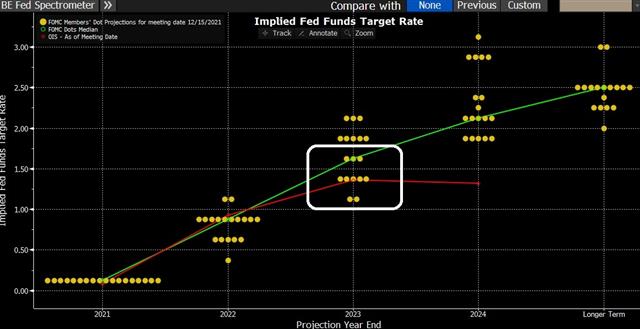Market reaction to Wednesday's FOMC decision differs from most other reactions in the way it has so far turned out.
So why did the U.S. dollar and bond yields fail to break higher despite the Fed's decision to double its tapering from $15 billion to $30 billion to signal faster rate hikes for 2022?
The answer lies in the chart below.

The chart shows how the red graph of OIS curve (Overnight Index curve) disagrees with the Fed’s rate hike expectations. Said differently, the red graph links the red dots of median projections for the Fed funds rate according to the market, versus the yellow dots, linked by the median projections from each FOMC member. Thus, the red graph for 2023 is substantially lower than the yellow graph, meaning the “market” expects between one and two rate hikes in 2023 versus three rate hikes by the median of FOMC members (yellow graph).
The reason markets assert the U.S. economy cannot handle that much tightening is due to the taxing nature of inflation on consumer demand. As opposed to demand-driven inflation, which lifts prices thanks to broadening strength in incomes and consumption, supply-driven inflation is mainly a manifestation of shortages and higher energy costs. Even if some of the inflation ends up remaining (sticking), the U.S. consumer simply cannot handle five of six rate hikes.
The Bank of England’s decision to hike rates amid a deteriorating virus situation and the ECB’s relatively hawkish message were cases of the central bank’s attempt not to be left in the inflation curve. The BoE rate hike’s short-lived positive impact on GBP clearly indicates that decision was mainly a ceremonious step to acknowledge inflation.
